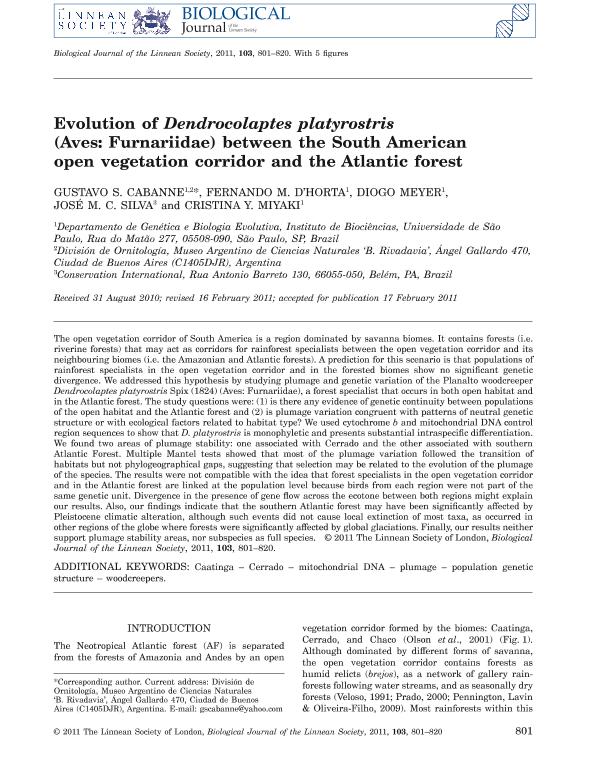Mostrar el registro sencillo del ítem
dc.contributor.author
Cabanne, Gustavo Sebastián

dc.contributor.author
D'Horta, Fernando M.
dc.contributor.author
Meyer, Diogo
dc.contributor.author
Silva, José M. C.
dc.contributor.author
Miyaki, Cristina Yumi

dc.date.available
2020-02-19T20:39:11Z
dc.date.issued
2011-08
dc.identifier.citation
Cabanne, Gustavo Sebastián; D'Horta, Fernando M.; Meyer, Diogo; Silva, José M. C.; Miyaki, Cristina Yumi; Evolution of Dendrocolaptes platyrostris (Aves: Furnariidae) between the South American open vegetation corridor and the Atlantic forest; Wiley Blackwell Publishing, Inc; Biological Journal of The Linnean Society; 103; 4; 8-2011; 801-820
dc.identifier.issn
0024-4066
dc.identifier.uri
http://hdl.handle.net/11336/98078
dc.description.abstract
The open vegetation corridor of South America is a region dominated by savanna biomes. It contains forests (i.e. riverine forests) that may act as corridors for rainforest specialists between the open vegetation corridor and its neighbouring biomes (i.e. the Amazonian and Atlantic forests). A prediction for this scenario is that populations of rainforest specialists in the open vegetation corridor and in the forested biomes show no significant genetic divergence. We addressed this hypothesis by studying plumage and genetic variation of the Planalto woodcreeper Dendrocolaptes platyrostris Spix (1824) (Aves: Furnariidae), a forest specialist that occurs in both open habitat and in the Atlantic forest. The study questions were: (1) is there any evidence of genetic continuity between populations of the open habitat and the Atlantic forest and (2) is plumage variation congruent with patterns of neutral genetic structure or with ecological factors related to habitat type? We used cytochrome b and mitochondrial DNA control region sequences to show that D. platyrostris is monophyletic and presents substantial intraspecific differentiation. We found two areas of plumage stability: one associated with Cerrado and the other associated with southern Atlantic Forest. Multiple Mantel tests showed that most of the plumage variation followed the transition of habitats but not phylogeographical gaps, suggesting that selection may be related to the evolution of the plumage of the species. The results were not compatible with the idea that forest specialists in the open vegetation corridor and in the Atlantic forest are linked at the population level because birds from each region were not part of the same genetic unit. Divergence in the presence of gene flow across the ecotone between both regions might explain our results. Also, our findings indicate that the southern Atlantic forest may have been significantly affected by Pleistocene climatic alteration, although such events did not cause local extinction of most taxa, as occurred in other regions of the globe where forests were significantly affected by global glaciations. Finally, our results neither support plumage stability areas, nor subspecies as full species. © 2011 The Linnean Society of London.
dc.format
application/pdf
dc.language.iso
eng
dc.publisher
Wiley Blackwell Publishing, Inc

dc.rights
info:eu-repo/semantics/openAccess
dc.rights.uri
https://creativecommons.org/licenses/by-nc-sa/2.5/ar/
dc.subject
CAATINGA
dc.subject
CERRADO
dc.subject
MITOCHONDRIAL DNA
dc.subject
PLUMAGE
dc.subject
POPULATION GENETIC STRUCTURE
dc.subject
WOODCREEPERS
dc.subject.classification
Genética y Herencia

dc.subject.classification
Ciencias Biológicas

dc.subject.classification
CIENCIAS NATURALES Y EXACTAS

dc.title
Evolution of Dendrocolaptes platyrostris (Aves: Furnariidae) between the South American open vegetation corridor and the Atlantic forest
dc.type
info:eu-repo/semantics/article
dc.type
info:ar-repo/semantics/artículo
dc.type
info:eu-repo/semantics/publishedVersion
dc.date.updated
2020-02-07T13:40:47Z
dc.journal.volume
103
dc.journal.number
4
dc.journal.pagination
801-820
dc.journal.pais
Reino Unido

dc.journal.ciudad
Londres
dc.description.fil
Fil: Cabanne, Gustavo Sebastián. Consejo Nacional de Investigaciones Científicas y Técnicas. Oficina de Coordinación Administrativa Parque Centenario. Museo Argentino de Ciencias Naturales “Bernardino Rivadavia”; Argentina
dc.description.fil
Fil: D'Horta, Fernando M.. Universidade de Sao Paulo; Brasil
dc.description.fil
Fil: Meyer, Diogo. Universidade de Sao Paulo; Brasil
dc.description.fil
Fil: Silva, José M. C.. Conservation International; Brasil
dc.description.fil
Fil: Miyaki, Cristina Yumi. Universidade de Sao Paulo; Brasil
dc.journal.title
Biological Journal of The Linnean Society

dc.relation.alternativeid
info:eu-repo/semantics/altIdentifier/doi/https://doi.org/10.1111/j.1095-8312.2011.01678.x
dc.relation.alternativeid
info:eu-repo/semantics/altIdentifier/url/https://academic.oup.com/biolinnean/article/103/4/801/2452596
Archivos asociados
